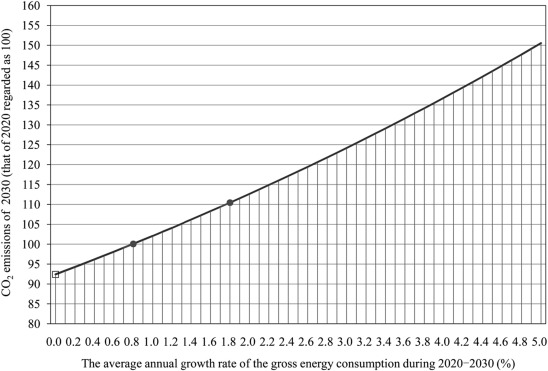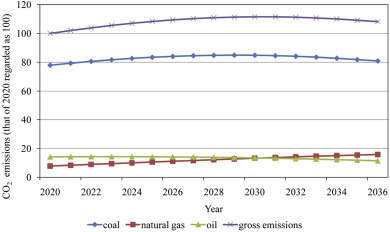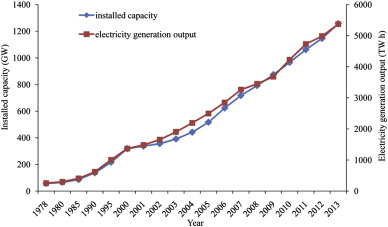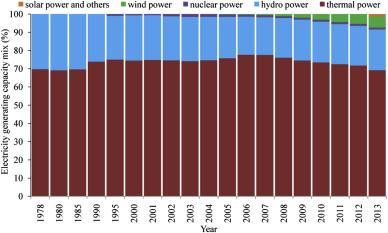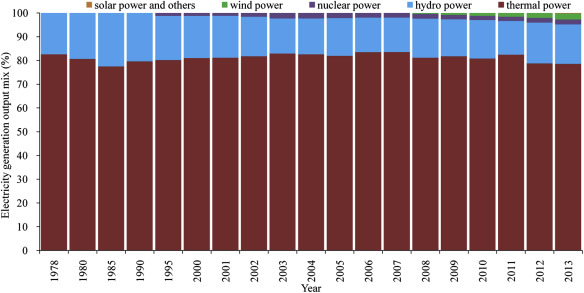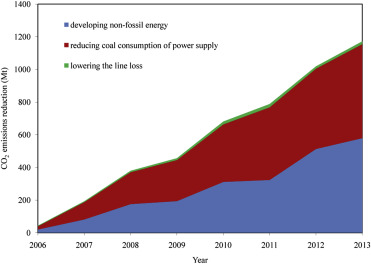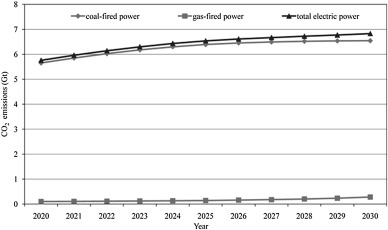Abstract
Chinas energy carbon emissions are projected to peak in 2030 with approximately 110% of its 2020 level under the following conditions: 1) Chinas gross primary energy consumption is 5 Gtce in 2020 and 6 Gtce in 2030; 2) coals share of the energy consumption is 61% in 2020 and 55% in 2030; 3) non-fossil energys share increases from 15% in 2020 to 20% in 2030; 4) through 2030, Chinas GDP grows at an average annual rate of 6%; 5) the annual energy consumption elasticity coefficient is 0.30 in average; and 6) the annual growth rate of energy consumption steadily reduces to within 1%. Chinas electricity generating capacity would be 1,990 GW, with 8,600 TW h of power generation output in 2020. Of that output 66% would be from coal, 5% from gas, and 29% from non-fossil energy. By 2030, electricity generating capacity would reach 3,170 GW with 11,900 TW h of power generation output. Of that output, 56% would be from coal, 6% from gas, and 37% from non-fossil energy. From 2020 to 2030, CO2 emissions from electric power would relatively fall by 0.2 Gt due to lower coal consumption, and relatively fall by nearly 0.3 Gt with the installation of more coal-fired cogeneration units. During 2020–2030, the portion of carbon emissions from electric power in Chinas energy consumption is projected to increase by 3.4 percentage points. Although the carbon emissions from electric power would keep increasing to 118% of the 2020 level in 2030, the electric power industry would continue to play a decisive role in achieving the goal of increase in non-fossil energy use. This study proposes countermeasures and recommendations to control carbon emissions peak, including energy system optimization, green-coal-fired electricity generation, and demand side management.
Keywords
Energy consumption ; Growth rate ; Carbon emissions peak ; Electric power development
1. Estimates of energy consumption and carbon emissions peak
1.1. The U.S.–China Joint Announcement on Climate Change
On November 12, 2014, China and the U.S. issued the U.S.–China Joint Announcement on Climate Change in Beijing. Under the agreement, “China intends to achieve the peaking of CO2 emissions around 2030 and to make best efforts to peak early and intends to increase the share of non-fossil energy in primary energy consumption to around 20% by 2030. Both sides intend to continue to work to increase ambition over time.” The Announcement focused on four key points that were relevant to this study. First, Chinas carbon emissions (hereinafter carbon emissions) will peak around 2030 and China will make best efforts to peak early, which means the peaking should occur no later than 2035, even could be prior to 2030 with effort. Second, although the exact value of emissions peaking was not defined in the Announcement, it will not be randomly increased because the peaking of carbon emissions will reflect a goal of approximately 20% non-fossil energy in primary energy consumption by 2030, and because actions to combat climate change contained in the Announcement will facilitate peaking ahead of schedule.
1.2. Estimates of carbon emissions peak
The high carbon content of Chinas energy resources contributes significantly to carbon emissions. According to The Peoples Republic of China Second National Communication on Climate Change (DCCNDRC, 2013 ), not including land use, land use change and forestry (LULUCF), Chinas greenhouse gas emissions from energy production in 2005 were approximately 5.769 Gt CO2 -eq, accounting for 77.3% of national total greenhouse gas emissions. Because the production of steel and cement will peak before 2020 (Zhang, 2015 and Gao, 2013 ) and carbon emissions from LULUCF have relatively low impacts, the peak value of Chinas carbon emissions will be determined almost entirely by energy consumption. Therefore, this study would analyze Chinas carbon emissions peak from energy consumption.
Because carbon emissions from energy consumption are influenced by a number of factors such as economy, social trends, energy, and environment, accurate forecasts of the trends in carbon emissions are difficult. Nevertheless, on the basis of current economic development trends and energy plans and policies already proposed by the government, future carbon emissions and the uncertainty could be reasonably estimated and analyzed.
In this study, factors used to estimate carbon emissions peak fell into two categories. The first category was based on Chinas National Plan on Climate Change (2014–2020) (NDRC, 2014 ) and the Energy Development Strategy Action Plan (2014–2020) (SCPRC, 2014 ). In the two plans, a cap of approximately 4.8 Gtce was established for Chinas energy consumption for 2020 with a cap on coal consumption set at 4.2 Gt. By 2020, the share of coal consumption in the total primary energy mix would be reduced to below 62%, and the share of non-fossil energy would increase to 15%. Accordingly, for the purpose of forecasting and analysis, this study chose 5 Gtce for primary energy consumption, 61% for coal consumption, and 10% for natural gas consumption in the total primary energy mix.
The second category included the following hypothetical propositions for forecasting and analysis proposed by the authors on the basis of our understanding of existing research: a) economic growth from 2020 to 2030 would be moderate and stable, and the annual growth rate of both the economy and the energy consumption would continue to decrease; b) by 2030, the share of natural gas in the total energy mix would increase to 14%, while the share of oil and coal would be reduced to 11% and 55%, respectively; c) non-fossil energy would be defined as carbon-free energy; and d) the emission coefficient will remain unchanged because the continuous technological advances in power industry of China in the past ten-odd years has tapped most of the potential of further increasing energy efficiency.
Using 2020 carbon emissions as the benchmark of 100, the average annual growth rate in gross energy consumption and carbon emissions from 2020 to 2030 were estimated on the basis of shares of non-fossil energy, coal, natural gas, and oil outlined above. The formulas are presented in Equations (1) and (2) .
|
|
( 1) |
|
|
( 2) |
: 2030 carbon emissions assuming 2020 carbon emissions as 100; : gross primary energy consumption in 2030 (Gtce); QC : gross primary energy consumption in 2020 (Gtce); : percentage of fossil energy i in the total 2030 energy consumption; ai : percentage of fossil energy i in the total 2020 energy consumption; bi : carbon emissions coefficient of fossil energy i , including coal, oil, natural gas, etc; c : average annual growth rate (%) of gross energy consumption from 2020 to 2030.
The results of these formulas are presented in Fig. 1 .
|
|
|
Fig. 1. Relations between the average annual growth rate of gross energy consumption and carbon emissions of energy consumption from 2020 to 2030. The CO2 emissions of raw coal were 2.66 t CO2 (tce)−1 , the CO2 emissions of natural gas were 1.63 t CO2 (tce)−1 , and the CO2 emissions of oil were 2.11 t CO2 (tce)−1 . The differences in carbon content and carbon oxidation rate per unit of calorific value of coal, natural gas, and oil were not taken into account in the calculations. Though varied in different researches, the value of CO2 emission factor had little impact on the result. This was calculated based on AQSIQ (2008) and NDRC (2011) .
|
As shown in Fig. 1 , the average annual growth rate of energy consumption has a nearly linear relation with carbon emissions. In the absence of LULUCF, if the annual growth of energy consumption was zero, Chinas 2030 carbon emissions would be 92% of its 2020 level. This means carbon emissions would have peaked in 2020. If the annual growth of gross energy consumption averaged approximately 0.8%, Chinas carbon emissions in 2030 would be on a par with 2020 level. Carbon emissions would peak slightly later than 2020. Or, if the average annual growth rate of energy consumption were capped at 0.8% (taking other measures of carbon emissions reduction into account, this rate can be capped at 1%), the carbon emissions peak would be achieved. If the annual growth rate of GDP averaged 6%, and the average annual energy consumption elasticity coefficient was 0.30 (reflecting an annual energy consumption growth rate of approximately 1.8% and continued declines to below 1% in 2030), carbon emissions in 2030 would be approximately 110% of its 2020 level. For the purpose of this study, we defined this as the Relatively Ideal Scenario. When considering the effect of carbon sink, early peaking might be achieved and the peak value might be lower. If the assumptions in the Relatively Ideal Scenario, are applied in Equation (1) , emissions of coal, natural gas, and oil, and overall energy consumption would be expressed as presented in Fig. 2 .
|
|
|
Fig. 2. Carbon emissions and energy consumption in 2020–2036 under the Relatively Ideal Scenario.
|
If the annual growth rate of energy consumption averaged 1.8% during 2020–2030 and declined from 2.8% in 2021 to 1% in 2030, Chinas carbon emissions would peak in 2030, reflecting an increase of approximately 1.2 Gt over that of 2020 level. The growth rate of energy consumption would be critical to achieving the goal for peaking. Peaking by 2030 would require reducing the growth rate of energy consumption as a precondition. It would also require a relatively low and stable energy growth rate. The peaking of the carbon emissions would occur earlier than the peaking of energy consumption. In general, increasing carbon emissions from natural gas would be counteracted by decreasing carbon emissions from oil. Under the premise of making the best of coal, phasing out high-carbon energy with non-fossil energy would play an important role to achieve the carbon emissions peaking.
1.3. Factors affecting carbon emissions peaking
The first challenge to the goal of emissions peaking is reflected primarily in the close relation between the rates of growth in economic development and energy consumption. The rate of growth in energy consumption will determine the timing and magnitude of the peak. The earlier peaking can be achieved, the lower the magnitude of emissions at the peak will be. In a stagnant or slow-growing economy, carbon emissions would peak earlier with smaller in magnitude. By contrast, in an over-heated economy, the growth in energy consumption would be high, the magnitude of the carbon emissions peak would be higher, and the peak would likely be delayed beyond 2035.
The second challenge focuses on the timing of the carbon emissions peaking, which may not keep pace with the rate of decline in energy consumption. This would be determined primarily by the proportion of low-carbon energy consumption and the stringency of any requirements for the reduction of carbon intensity per unit of GDP. The more stringent the measures for carbon emissions reduction (e.g., greater share of non-fossil energy, or increased natural gas consumption replacing coal), the lower the peak value would be. However, influenced by the growth rate of energy consumption, the peak may not be achieved earlier. Notable here is that the analysis above is significant only under a stable rate of growth in energy consumption, which would continue its downward trend. In the period from 2020 to the peaking, the abrupt high-speed growth in one or more years would impact the timing of the peaking and the peak value. With a relatively high and continually increasing annual rate of growth in energy consumption, the carbon emissions peak would be delayed unless the growth in energy consumption encounters a cliff in 2030. Viewed from the standpoint of risk analysis, the word around in the Announcement for both the peak timing and the share of non-fossil energy in overall energy consumption is quite necessary.
2. Impact of the power industry carbon emissions peaking
2.1. Current status of the power industry and reduction of carbon emissions
In the past few years, China made significant efforts to restructure the domestic power industry. The growth of non-fossil energy accelerated, the optimization of thermal power units progressed, and energy efficiency continued to increase (CEC, 2008 and CEC, 2014 ). By late 2013, the total installed energy production capacity in China reached 1,258 GW. This represented an increase of 726 times over that of 1949, when the Peoples Republic of China was founded. Chinas output of generated electricity in 2013 was 5,370 TW h, an increase in magnitude of 1,248 times over that of 1949. Chinas annual electricity generation has ranked first in the world since 2010. In terms of power generation mix, installed hydropower capacity reached 280 GW, an increase of 12.4% over that of 2012. Installed thermal power capacity reached 870 GW, an increase of 6.1% over that of 2012. Nuclear power increased by 16.6% over that of 2012 to 14.66 GW, and the combined capacity of new nuclear power plants under construction in China ranked first in the world. Installed wind power capacity ranked first in the world, increasing 24.6% over that of 2012 to 76.52 GW. Solar power capacity increased by a staggering 365.8% over 2012 to 15.89 GW. The generating capacity of non-fossil energy facilities (hydropower, nuclear, solar, wind, etc.) accounted for 30.8% of total generating capacity, up by 6.5 percentage points compared with that of 2005.
Thermal power units with a capacity of 300 MW or higher represented 76.5% of total thermal installed capacity, up by 0.7 percentage point over that of 2012. The thermal power capacity mix was dominated by coal-fired power plants. Power generated by coal-fired units accounted for 74.1% of total electricity generation. A total of 63 ultra-super-critical coal-fired generating units of 1,000 MW had been installed. China continued its efforts to greater energy efficiency in coal-fired power plants. By 2013, the efficiency of thermal power units in China averaged 38.3% (not including the service power consumed by the power plants), and the efficiency of the best performing units reached 44.5%, and coal-fired plants in China were among the most efficient in the world. Chinas electric power development and efforts in energy conservation and reductions of emissions are presented in Fig. 3 , Fig. 4 , Fig. 5 and Fig. 6 .
|
|
|
Fig. 3. Installed capacity and electricity generation in China (1978–2013).
|
|
|
|
Fig. 4. Mix of electricity generating capacity in China (1978–2013).
|
|
|
|
Fig. 5. Mix of electricity generation output in China (1978–2013).
|
|
|
|
Fig. 6. Types of CO2 emission reductions in the electric power industry (2006–2013, using 2005 as the baseline year).
|
On the basis of the data presented in Fig. 3 , Fig. 4 , Fig. 5 and Fig. 6 , we concluded the following: 1) With the rapid growth during the past 30 years, energy efficiency and control of pollution in Chinas power industry has improved significantly. The last 10 years has undergone great achievements in the areas of renewable energy and clean coal power generation. 2) The carbon intensity of Chinas power industry has been decreasing since 2005. Using 2005 as the baseline, CO2 emissions were relatively reduced by approximately 4.73 Gt from 2006 to 2013, which slowed down the growth rate of carbon emissions. This was accomplished through such measures as development of non-fossil energy sources, reduction of coal consumption for power supply, and lowering line loss. The reduction of coal consumption and the increase in use of non-fossil energy contributed to 51% and 47%, respectively, of the overall reduction in electric power CO2 emissions (CEC, 2014 ). According to statistics of the IEA, the carbon intensity of the electric power industry in China was 867 g (kW h)−1 in 2005, and dropped by 109 g (kW h)−1 to 758 g (kW h)−1 in 2010. 3) As coal would still dominate Chinas primary energy consumption and remain as the major power generation source in the near future, carbon emissions reduction would be a long haul for China.
2.2. Estimates of power industry development and control of emissions in 2020 and 2030
2.2.1. Power industry development forecast for 2020 and 2030
When forecasting power industry development in China, consideration should be given to a number of factors such as economic development, social and cultural trends, national policies and priorities, and the nations endowment of energy resources. On the basis of the existing national planning and forecasts (DPDSGCC and SGERI, 2012 , Xia and Fu, 2009 , Wang, 2013 and Lin, 2009 ), Table 1 presents forecasts of the power industrys installed capacity and mix of power generation sources in 2020 and 2030.
| Type | Year | Installed capacity | Percentage | Annual generation output | Percentage |
|---|---|---|---|---|---|
| (GW) | (%) | (TW h) | (%) | ||
| Total | 2013 | 1,258 | 100 | 5,372 | 100 |
| 2020 | 1,993 | 100 | 8,560 | 100 | |
| 2030 | 3,170 | 100 | 11,930 | 100 | |
| Coal-fired | 2020 | 1,100 | 55.2 | 5,800 | 66.0 |
| 2030 | 1,450 | 45.7 | 6,700 | 56.2 | |
| Gas-fired | 2020 | 135 | 6.8 | 280 | 5.0 |
| 2030 | 220 | 6.9 | 770 | 6.5 | |
| Fossil fuels | 2020 | 1,230 | 62.0 | 6,080 | 71.0 |
| 2030 | 1,670 | 52.7 | 7,470 | 62.6 | |
| Hydro | 2020 | 360 | 18.1 | 1,250 | 14.6 |
| 2030 | 480 | 15.1 | 1,680 | 14.1 | |
| Pumped storage | 2020 | 60 | 3.0 | ||
| 2030 | 150 | 4.7 | |||
| Nuclear | 2020 | 58 | 2.9 | 470 | 5.7 |
| 2030 | 200 | 6.3 | 1,500 | 12.6 | |
| Wind | 2020 | 200 | 10.0 | 650 | 7.6 |
| 2030 | 350 | 11.0 | 800 | 6.7 | |
| Solar | 2020 | 70 | 3.5 | 110 | 1.1 |
| 2030 | 300 | 9.5 | 480 | 4.0 | |
| Others | 2020 | 10 | 0.5 | ||
| 2030 | 20 | 0.6 | |||
| Non-fossil energy | 2020 | 770 | 38.0 | 2,480 | 29.0 |
| 2030 | 1,500 | 47.3 | 4,460 | 37.4 |
On the basis of the forecast in Table 1 , Table 2 forecasts the share of non-fossil energy used to generate electricity in the total primary energy consumption in 2020 and 2030.
| Year | Hydro | Nuclear | Wind | Solar | Total |
|---|---|---|---|---|---|
| 2020 | 7.5 | 2.8 | 3.9 | 0.7 | 14.9 |
| 2030 | 8.1 | 7.3 | 3.9 | 2.3 | 21.6 |
Note: The contributing share was calculated using the equivalent method.
2.2.2. Forecast of carbon emissions in power industry
2.2.2.1. Total energy consumption scenario
Total energy consumption was forecasted on the basis of the factors and assumptions in the Relatively Ideal Scenario: Total primary energy consumption in 2020 will be regulated below 5 Gtce; the annual growth rate of GDP will be 6% in average, the annual energy consumption elasticity coefficient will average 0.30; the annual growth rate in energy consumption will average 1.8%; and national primary energy consumption in 2030 will be approximately 6 Gtce. From 2020 to 2030, the average annual rate of growth in power generation output will be 3.38% with a generation elasticity coefficient of 0.563.
2.2.2.2. Forecast of related electric power parameters
The efficiency of thermal power units is affected by the following factors: a) technological progress facilitates continuous improvements in the efficiency of existing and new power plants; b) the contribution of new power plants to overall efficiency will be reduced because over 70% of the total current installed capacity was constructed during the last 10 years; c) the constant growth of renewable energy generation would push up the peak load regulation demand of coal-fired power plants, influencing improvements in the efficiency of coal-fired units; and d) improvements in the efficiency of pollutant control equipment and facilities increases overall power consumption. The efficiency of coal-fired and gas-fired power generation would increase to 41% (from 38.7% in 2014) and 53.5% respectively in 2020, which would be enhanced to 42.4% and 54.7% respectively in 2030.
In the future, the power generation carbon emissions coefficient is expected to hold the line, considering the trends in the development of fossil fuel generation technology and other factors. According to the provincial greenhouse gas emissions inventory survey data, the public utility boiler coal weighted emission factor in 2008 was 1.92 t CO2 per ton of coal. If the raw coal average low calorific value was 19,638 kJ (kg)−1 , the power generation coal carbon emission factor should be 2.86 t CO2 (tce)−1 . Carbon emissions from gas and oil power generation, as well as the national complex utilization gas and oil, are almost the same, 1.63 t CO2 (tce)−1 for gas and 2.11 t CO2 (tce)−1 for oil.
The coal consumed by the power sector consists of two parts, power generation and heating. Coal consumption for power generation is calculated by converting generation output into the standard coal equivalent while coal consumption for heating is calculated based on its proportion in the overall coal consumption. In 2013, cogeneration units for heat and power accounted for 28.7% of the thermal power units with approximately 10% of the overall power sector coal consumption used for heating. Because cogeneration of heat and power would be further extended as an energy cascade utilization method, the portion of coal used for heating in the overall power sector is expected to increase to 12% in 2020 and 15% in 2030. The calculated results are summarized in Fig. 7 .
|
|
|
Fig. 7. CO2 emissions from electric power in 2020–2030.
|
On the basis of Table 2 and Fig. 7 , we offer the following conclusions: 1) Electric power carbon emissions are expected to increase from 2020 to 2030, with 2030 emissions at 118% of 2020 level. 2) The portion of total carbon emissions contributed by electric power is expected to increase by 3.4 percentage points from 55.4% in 2020 to 58.8% in 2030. The increase will be due primarily to a greater ratio of electric power in end-use energy consumption resulting from the substitution of coal for scattered burning, industrial boilers, and households with electricity. 3) From 2020 to 2030, the average growth rate for coal-fired power in the first five years will be higher than the second five years, while the pace of substitution of gas for coal-fired power and non-fossil energy will be higher during the second five years. 4) Improvements in generation efficiency would lead to a relative reduction of approximately 0.2 Gt of CO2 emissions in 2030 as compared with that of 2020; the increase in coal-fired cogeneration of heat and power would add 0.1 Gtce in consumption, whereas the increase in energy efficiency would be equivalent to 0.2 Gt of scattered burning coal being replaced, or a relative reduction of nearly 0.3 Gt of CO2 emissions, which slowed down the growth rate of carbon emissions. 5) The output of non-fossil energy power generation is expected to be 4,460 TW h in 2030. Non-fossil energy used for power generation would comprise 21.6% of the national primary energy consumption (6 Gtce), compared to the national goal of 20% by 2030. In other words, the power industry would play a decisive role in Chinas target to increase the share of non-fossil energy in primary energy consumption. However, our analysis assumes that national primary energy consumption in 2030 will be approximately 6 Gtce, representing a 1.8% average annual growth rate in energy consumption beginning in 2020. This assumption represents a daunting goal for the nation. A more realistic goal might be 6.5 Gtce. When energy consumption reaches 6.5 Gtce in 2030 simultaneously with emissions peaking, development of non-fossil energy power generation must be further enhanced. Therefore, the principle presented in this study that electric power generation should grow moderately ahead of the economy, is aimed at enhancing the development of non-fossil energy power generation. The 20% target could still be fulfilled by utilizing non-fossil energy, even if energy consumption achieves the 6.5 Gtce goal in 2030. Meanwhile, the peak value would be higher due to the growth in total energy consumption, and the peak time would depend on the inter-annual distribution of the growth rate in energy consumption.
3. Industry measures to facilitate carbon emissions peaking
The following measures are recommended to facilitate carbon emissions peaking.
- Optimize the energy system centered on electric power. Challenged by multiple impacts of the high carbon energy mix, pollution and carbon emission accelerated measures should be taken to achieve the six key goals of energy strategy with multiple benefits, i.e. safe, efficient, green, economical, convenient, and harmonious (Wang, 2014 ). Replacing coal and oil with electricity so as to increase the share of electricity consumption in the end-use energy consumption will be the keynote of the energy strategy.
- Coordinate the development of non-fossil energy, energy storage and power grid. The development of non-fossil energy will play a decisive role in carbon emissions peaking with several bottlenecks to be addressed: a) actively and orderly accelerate the development of hydro power, nuclear power, wind power and solar power in order to increase the non-fossil energy portion of the national energy portfolio; b) accelerate the development of conventional pumped storage as the essential energy storage mode and explore new storage technology to ensure large-scale construction, grid access, and full use of renewable energy sources; and c) reinforce the coordination between new energy generation and peak load power supply, the consumer market and power grid development.
- Achieve goals for coal-fired power generation to be clean and green through the following measures: a) constantly improve the efficiency of energy conversion and pollution control by advancing science and technology; b) explore and utilize customized technology for CO2 absorption, capture, use and storage; c) improve coal energy and resource effectiveness by accelerating the cogeneration of heat and coal and other modes of energy cascade use; and d) optimize the operation of different power sources through grid dispatching and other grid technologies.
- Reinforce power demand side management and demand side response, highlight the role of electric power in resources allocation of the whole society, energy conservation and carbon emissions reduction, and make the best of the renewable energy. On the one hand, include the electricity sourced from demand side conservation and load transfer in the system planning; on the other hand, effectively use the feed-in electricity generated from renewable energy of the distributed energy sources.
4. Conclusions
- The keys to achieve the goals for peaking are the average growth rate in Chinas energy consumption and its yearly distribution. Given the proportion goal of non-fossil energy consumption, if the annual growth rate of total energy consumption averaged 1.8%, Chinas energy carbon emissions peak value would be approximately 110% of the 2020 level.
- This study defined the Relatively Ideal Scenario for the period 2020–2030 in which the annual growth rate of energy consumption averaged 1.8%, continued to decline, and dropped below 1% in 2030.
- The electric power industrys low carbon development would play a decisive role in achieving the goal for Chinas carbon emissions peaking. On the basis of the principle that electric power generation should grow moderately ahead of the economy and low carbon development, the study forecasted that in 2020, Chinas electricity generating capacity would be 1,990 GW with 8,600 TW h of power generation output. This would be comprised of 66% coal, 5% gas and 29% non-fossil energy. In 2030, Chinas electricity generating capacity would reach 3,170 GW with 11,900 TW h of power generation output, composed of 56% coal, 6% gas, and 37% non-fossil energy power generation. Compared with that of 2020 level, electric power carbon emissions in 2030 would relatively fall by 0.2 Gt due to lower coal consumption, and relatively by nearly 0.3 Gt due to the increased coal-fired cogeneration units. The portion of electric power carbon emissions in the overall carbon emissions of energy consumption would rise by 3.4 percentage points with enhanced electric power by substituting coal for scattered burning, industrial boilers, and households with electricity. However, electric power carbon emissions would continue increasing and reach 118% of the 2020 level in 2030.
- Three aspects should be reinforced in accelerating carbon emissions reduction for electric power industry: a) progress in optimizing the energy system centered on electric power and based on the principle that the electric power should grow moderately ahead of the economy; b) coal-fired power generation must achieve the goal of clean and green; and c) reinforcing power demand management in promoting energy conservation and carbon emissions reduction for everyone.
Before 2030, the pace of Chinas modernization should not slow down too much in order to achieve the carbon emissions peaking, otherwise it would have negative effects on Chinas and even the worlds economy. On the basis of Chinas industrialization requirements, it should move forward with the energy revolution positively and reasonably to achieve green development. China should maintain reasonable levels of economic and energy consumption growth for the next 15 years, and gradually slow the growth rate in energy consumption during 2020–2030.
References
- AQSIQ, 2008 AQSIQ (General Administration of Quality Supervision, Inspection and Quarantine of the Peoples Republic of China); General Principles for Calculation of Total Production Energy Consumption; (2008) (in Chinese)
- CEC, 2008 CEC (China Electricity Council); China Electric Power Industry in 30 Years of Reform and Opening up; China Electric Power Press, Beijing (2008) (in Chinese)
- CEC, 2014 CEC (China Electricity Council); China Electric Power Industry Annual Development Report 2014; China Market Press, Beijing (2014) (in Chinese)
- DCCNDRC, 2013 DCCNDRC (Department of Climate Change, National Development and Reform Commission, China); The Peoples Republic of China Second National Communications on Climate Change; China Economy Press, Beijing (2013) (in Chinese)
- DPDSGCC and SGERI, 2012 DPDSGCC (Development Planning Department, State Grid Corporation of China), SGERI (State Grid Energy Research Institute); International Energy and Electricity Statistics; (2012) (in Chinese)
- Gao, 2013 Z. Gao; Cement consumption reach peak turning within five years; (2013) Accessed http://finance.eastmoney.com/news/1355, 20131218346703441.html (in Chinese)
- Lin, 2009 B.-Q. Lin; Important principles of electric power demand and scientific planning in the 12th-five-year plan; Power Decision-making Ref., 53 (4) (2009), pp. 3–11 (in Chinese)
- NDRC, 2011 NDRC(National Development and Reform Commission, China); Guidelines for the Drafting of the Provincial Level Greenhouse Gas Inventories; (2011) (in Chinese)
- NDRC, 2014 NDRC (National Development and Reform Commission, China); Chinas National Plan on Climate Change (2014–2020); (2014) (in Chinese)
- SCPRC, 2014 SCPRC (State Council of the People’s Republic of China); Energy Development Strategy Action Plan (2014–2020); (2014) (in Chinese)
- Wang, 2013 Z.-X. Wang; Strategic thinking of China coal-fired power in 2050; China Electr. Power Manag. (15) (2013), pp. 34–41 (in Chinese)
- Wang, 2014 Z.-X. Wang; Facing Smog, New Thinking on China Electric Power Development and Environmental Protection; China Electric Power Press, Beijing (2014) (in Chinese)
- Xia and Fu, 2009 Y.-S. Xia, Q.-Z. Fu; China International Energy Development Strategy Research; World Knowledge Press, Beijing (2009) (in Chinese)
- Zhang, 2015 G.-N. Zhang; The steel output in peak period; (2015) Accessed http://www.csteelnews.com/xwzx/xydt/201501/t20150116_270145.html (in Chinese)
Document information
Published on 15/05/17
Submitted on 15/05/17
Licence: Other
Share this document
claim authorship
Are you one of the authors of this document?

